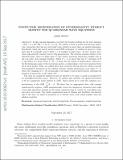| dc.contributor.author | Speck, Jared R. | |
| dc.date.accessioned | 2018-05-31T14:31:47Z | |
| dc.date.available | 2018-05-31T14:31:47Z | |
| dc.date.issued | 2017-08 | |
| dc.date.submitted | 2017-02 | |
| dc.identifier.issn | 1948-206X | |
| dc.identifier.issn | 2157-5045 | |
| dc.identifier.uri | http://hdl.handle.net/1721.1/116021 | |
| dc.description.abstract | In three spatial dimensions, we study the Cauchy problem for the wave equation −∂[superscript 2][subscript t]Ψ + (1+Ψ)[superscript P] ΔΨ=0 for P∈{1,2}. We exhibit a form of stable Tricomi-type degeneracy formation that has not previously been studied in more than one spatial dimension. Specifically, using only energy methods and ODE techniques, we exhibit an open set of data such that Ψ is initially near 0, while 1+Ψ vanishes in finite time. In fact, generic data, when appropriately rescaled, lead to this phenomenon. The solution remains regular in the following sense: there is a high-order L[superscript 2]-type energy, featuring degenerate weights only at the top-order, that remains bounded. When P = 1, we show that any C[superscript 1] extension of Ψ to the future of a point where 1 + Ψ = 0 must exit the regime of hyperbolicity. Moreover, the Kretschmann scalar of the Lorentzian metric corresponding to the wave equation blows up at those points. Thus, our results show that curvature blowup does not always coincide with singularity formation in the solution variable. Similar phenomena occur when P = 2, where the vanishing of 1 + Ψ corresponds to the failure of strict hyperbolicity, although the equation is hyperbolic at all values of Ψ.
The data are compactly supported and are allowed to be large or small as measured by an unweighted Sobolev norm. However, we assume that initially the spatial derivatives of Ψ are nonlinearly small relative to |∂[subscript t]Ψ|, which allows us to treat the equation as a perturbation of the ODE (d[superscript 2]/dt[superscript 2])Ψ = 0. We show that for appropriate data, ∂tΨ remains quantitatively negative, which simultaneously drives the degeneracy formation and yields a favorable spacetime integral in the energy estimates that is crucial for controlling some top-order error terms. Our result complements those of Alinhac and Lindblad, who showed that if the data are small as measured by a Sobolev norm with radial weights, then the solution is global. Keywords: degenerate hyperbolic; strictly hyperbolic; Tricomi equation; weakly hyperbolic | en_US |
| dc.description.sponsorship | National Science Foundation (U.S.) (Grant DMS-1162211) | en_US |
| dc.description.sponsorship | National Science Foundation (U.S.) (Grant DMS-1454419) | en_US |
| dc.publisher | Mathematical Sciences Publishers | en_US |
| dc.relation.isversionof | http://dx.doi.org/10.2140/APDE.2017.10.2001 | en_US |
| dc.rights | Creative Commons Attribution-Noncommercial-Share Alike | en_US |
| dc.rights.uri | http://creativecommons.org/licenses/by-nc-sa/4.0/ | en_US |
| dc.source | arXiv | en_US |
| dc.title | Finite-time degeneration of hyperbolicity without blowup for quasilinear wave equations | en_US |
| dc.type | Article | en_US |
| dc.identifier.citation | Speck, Jared. “Finite-Time Degeneration of Hyperbolicity Without Blowup for Quasilinear Wave Equations.” Analysis & PDE 10, 8 (August 2017): 2001–2030 | en_US |
| dc.contributor.department | Massachusetts Institute of Technology. Department of Mathematics | en_US |
| dc.contributor.mitauthor | Speck, Jared R. | |
| dc.relation.journal | Analysis & PDE | en_US |
| dc.eprint.version | Author's final manuscript | en_US |
| dc.type.uri | http://purl.org/eprint/type/JournalArticle | en_US |
| eprint.status | http://purl.org/eprint/status/PeerReviewed | en_US |
| dc.date.updated | 2018-05-30T16:45:00Z | |
| dspace.orderedauthors | Speck, Jared | en_US |
| dspace.embargo.terms | N | en_US |
| dc.identifier.orcid | https://orcid.org/0000-0001-5020-3568 | |
| mit.license | OPEN_ACCESS_POLICY | en_US |

